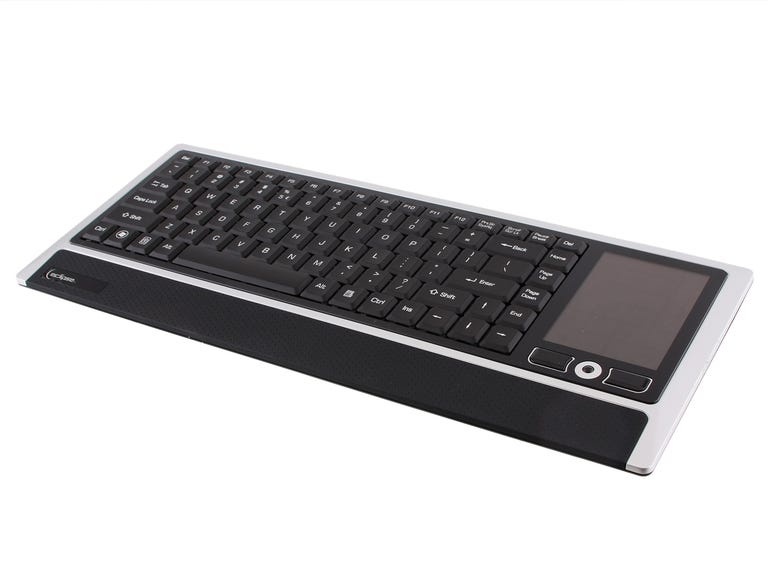 Why You Can Trust CNET
Why You Can Trust CNET Eclipse Wireless Litetouch review: Eclipse Wireless Litetouch
Eclipse Wireless Litetouch
The Mad Catz-owned Eclipse brand of computer accessories has just released a new touch LCD keyboard called Litetouch, aimed at the user who wants an elegant and stylized typing experience while also being able to customize various options.
The Good
The Bad
The Bottom Line
The Litetouch model keyboard is available in two versions, wireless and wired, and we recently got our hands on the former. The main attraction of the Litetouch has to be its customizable LCD touch screen; though we were intrigued by its addition, in practice it doesn't replace a conventional number keypad.
Design
The Wireless Litetouch keyboard has a minimalist design, making very good use of a small amount of space. The rectangular frame is outlined in a gray plastic, and the immediate area surrounding the keys is composed of a shiny black and harder material. Flanking the bottom is a rubberized black wrist guard, which we found to be comfortable and solid at preventing slippage.
The LCD touch screen itself houses a gorgeous display, with crisp, clear, and bright characters accenting the design. There's no give to the screen, so it's just like tapping on a solid iPad or iPhone screen.

Features
The biggest attraction of the Litetouch keyboard is without a doubt its touch LCD screen that can rotate between three different settings. There's a media screen for controlling music and managing shortcuts, a traditional number pad, and then a "MyEclipse" mode that lets you customize various buttons and actions. We'll review the performance of these features in the section below.
The Litetouch also has mouse control, complete with a small trackball and left and right click buttons flanking it on either side. The keyboard is also completely backlit, which, depending on preference, can be turned on or off.
Aside from the touch LCD screen, there are no other vanity buttons here.
Setup
Setting up our Litetouch keyboard was a mixed bag. We had absolutely no issues connecting the tiny 2.4GHz USB dongle to our PC and getting instant results. However, installing the software that's needed to manage the touch LCD screen was a completely different story.
Not only one, but two different PCs could not properly install the Smart Technology profile editor software that runs in tandem with the keyboard. When we finally were able to get the software installed, we could not run the appropriate application; it would just crash upon loading up. We yielded the same results on another PC in our office until the third computer we came across was finally able to run the software.
We should note that attempts to recover a more recent version of the software were unsuccessful because of issues with the company's site; the last attempt was just minutes before we handed in this review.
Fortunately, the keyboard still worked with the two PCs that didn't install the software, so we weren't left with a useless accessory. That said, the MyEclipse mode on the LCD touch screen did not work.
When the Smart Technology software is properly installed, users have the ability to customize the MyEclipse LCD mode, assigning programs to different hot keys and button icons. The software interface is clean and simplistic, encouraging the user to drag and drop programs and Web sites to the various buttons represented onscreen. Overall, it was a cinch to use.
Performance
We were pleased with the overall performance of the physical keys on the keyboard, but we quickly became disappointed with how the touch LCD behaved. Before we explain the problems, we should note that these issues occurred both on the PCs without the software and on those with it.
Almost right away we noticed a serious lag when switching between LCD modes. Three mode buttons rest along the top and had to be pressed twice, even three times occasionally to get the screen to switch. A small audible click can be heard when registering a successful touch, and we used this as a clear indicator of the keyboard's responsiveness.
Not only during mode-switching did the touch screen fail us. Numerous instances of locking up and extended periods of unresponsiveness was common, which really dampened the overall experience.
As if that wasn't enough, we also occasionally had to deal with phantom repeating of characters, physical and nonphysical keys alike. Also, the location of the bottom-left touch key was accidentally pressed a lot, which, in our case, was the mute button for music. We really wish there were options in place to move around some of these touch-button locations.
There is a virtual slider that can control volume or keyboard brightness; it felt jittery and mostly unresponsive as well.
As far as the physical keys were concerned, we enjoyed their soothing soft, quiet performance. Typing on these backlit keys in the dark was also a delight, and the ability to change the board's brightness was a nice touch.
The mouse controls below the touch screen performed surprisingly well, with the trackball providing more accuracy than we thought the small BB-size pellet was capable of. The left and right click buttons also had no issues during our testing. Over time, we found ourselves using them instead, when reaching for the mouse felt unnecessary.

A rechargeable battery inside the Litetouch nets around 20 hours of use, so you'll have to keep the AC adapter close by.
Conclusion
It's going to be tough to give the $130 Eclipse Wireless Litetouch keyboard a recommendation simply because of the laundry list of issues with the product's LCD touch screen. Though we suppose these kinks can be worked out with a firmware update, we found the version sold as-is to border on the line of unacceptability. We haven't seen many attempts at touch LCD screens on a keyboard, so we can't really recommend another product in its place, either. You're probably better off picking one out from our best-rated keyboard list.


